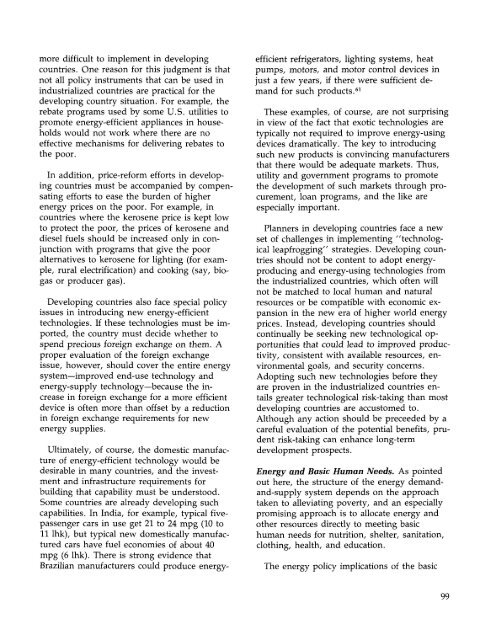ENERGY FOR A SUSTAINABLE WORLD - World Resources Institute
ENERGY FOR A SUSTAINABLE WORLD - World Resources Institute
ENERGY FOR A SUSTAINABLE WORLD - World Resources Institute
Create successful ePaper yourself
Turn your PDF publications into a flip-book with our unique Google optimized e-Paper software.
more difficult to implement in developing<br />
countries. One reason for this judgment is that<br />
not all policy instruments that can be used in<br />
industrialized countries are practical for the<br />
developing country situation. For example, the<br />
rebate programs used by some U.S. utilities to<br />
promote energy-efficient appliances in households<br />
would not work where there are no<br />
effective mechanisms for delivering rebates to<br />
the poor.<br />
In addition, price-reform efforts in developing<br />
countries must be accompanied by compensating<br />
efforts to ease the burden of higher<br />
energy prices on the poor. For example, in<br />
countries where the kerosene price is kept low<br />
to protect the poor, the prices of kerosene and<br />
diesel fuels should be increased only in conjunction<br />
with programs that give the poor<br />
alternatives to kerosene for lighting (for example,<br />
rural electrification) and cooking (say, biogas<br />
or producer gas).<br />
Developing countries also face special policy<br />
issues in introducing new energy-efficient<br />
technologies. If these technologies must be imported,<br />
the country must decide whether to<br />
spend precious foreign exchange on them. A<br />
proper evaluation of the foreign exchange<br />
issue, however, should cover the entire energy<br />
system—improved end-use technology and<br />
energy-supply technology—because the increase<br />
in foreign exchange for a more efficient<br />
device is often more than offset by a reduction<br />
in foreign exchange requirements for new<br />
energy supplies.<br />
Ultimately, of course, the domestic manufacture<br />
of energy-efficient technology would be<br />
desirable in many countries, and the investment<br />
and infrastructure requirements for<br />
building that capability must be understood.<br />
Some countries are already developing such<br />
capabilities. In India, for example, typical fivepassenger<br />
cars in use get 21 to 24 mpg (10 to<br />
11 lhk), but typical new domestically manufactured<br />
cars have fuel economies of about 40<br />
mpg (6 lhk). There is strong evidence that<br />
Brazilian manufacturers could produce energyefficient<br />
refrigerators, lighting systems, heat<br />
pumps, motors, and motor control devices in<br />
just a few years, if there were sufficient demand<br />
for such products. 61<br />
These examples, of course, are not surprising<br />
in view of the fact that exotic technologies are<br />
typically not required to improve energy-using<br />
devices dramatically. The key to introducing<br />
such new products is convincing manufacturers<br />
that there would be adequate markets. Thus,<br />
utility and government programs to promote<br />
the development of such markets through procurement,<br />
loan programs, and the like are<br />
especially important.<br />
Planners in developing countries face a new<br />
set of challenges in implementing "technological<br />
leapfrogging" strategies. Developing countries<br />
should not be content to adopt energyproducing<br />
and energy-using technologies from<br />
the industrialized countries, which often will<br />
not be matched to local human and natural<br />
resources or be compatible with economic expansion<br />
in the new era of higher world energy<br />
prices. Instead, developing countries should<br />
continually be seeking new technological opportunities<br />
that could lead to improved productivity,<br />
consistent with available resources, environmental<br />
goals, and security concerns.<br />
Adopting such new technologies before they<br />
are proven in the industrialized countries entails<br />
greater technological risk-taking than most<br />
developing countries are accustomed to.<br />
Although any action should be preceeded by a<br />
careful evaluation of the potential benefits, prudent<br />
risk-taking can enhance long-term<br />
development prospects.<br />
Energy and Basic Human Needs. As pointed<br />
out here, the structure of the energy demandand-supply<br />
system depends on the approach<br />
taken to alleviating poverty, and an especially<br />
promising approach is to allocate energy and<br />
other resources directly to meeting basic<br />
human needs for nutrition, shelter, sanitation,<br />
clothing, health, and education.<br />
The energy policy implications of the basic<br />
99

















